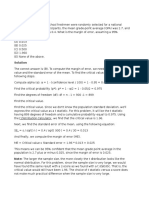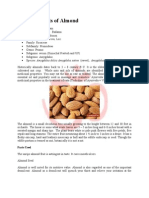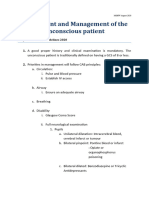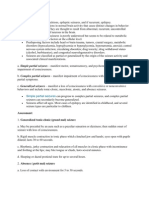Calculating The Sample Size
Uploaded by
sohelkuCalculating The Sample Size
Uploaded by
sohelkuCalculating the Sample Size
The sample size, in this case, refers to the number of children to be included in the survey.
Step 1: Base Sample-size Calculation
The appropriate sample size for a population-based survey is determined largely by three factors: (i) the
estimated prevalence of the variable of interest chronic malnutrition in this instance, (ii) the desired level
of confidence and (iii) the acceptable margin of error.
For a survey design based on a simple random sample, the sample size required can be calculated
according to the following formula.
Formula:
n= t x p(1-p)
m
Description:
n = required sample size
t = confidence level at 95% (standard value of 1.96)
p = estimated prevalence of malnutrition in the project area
m = margin of error at 5% (standard value of 0.05)
Example
In the Al Haouz project in Morocco, it has been estimated that roughly 30% (0.3) of the children in the
project area suffer from chronic malnutrition. This figure has been taken from national statistics on
malnutrition in rural areas. Use of the standard values listed above provides the following calculation.
Calculation:
n= 1.96 x .3(1-.3)
.05
n = 3.8416 x .21
.0025
n = .8068
.0025
n = 322.72 ~ 323
Step 2: Design Effect
The anthropometric survey is designed as a cluster sample (a representative selection of villages), not a
simple random sample. To correct for the difference in design, the sample size is multiplied by the design
effect (D).
The design effect is generally assumed to be 2 for nutrition surveys using cluster-sampling methodology.
Example
n x D = 323 x 2 = 646
Step 3: Contingency
The sample is further increased by 5% to account for contingencies such as non-response or recording
error.
Example
n + 5% = 646 x 1.05 = 678.3 678
Step 4: Distribution of Observations
Finally, the calculation result is rounded up to the closest number that matches well with the number of
clusters (30 villages) to be surveyed.
Thirty is the standard number of clusters established by the WHO Expanded Programme of Immunization
(EPI Cluster Surveys). There is no statistically necessary reason to maintain exactly 30 clusters, and the
number can be adjusted if there is a compelling motive for doing so.
Example
Final Sample Size: N = 690 children
The final sample size (N) is then divided by the number of clusters (30) to determine the number of
observations per cluster.
Example
N no. clusters = 690 30 = 23 children per village
General Rule: Standardized Sample Sizes for Nutrition Surveys
The following table provides the recommended sample size for various estimated levels of malnutrition,
incorporating standard values for confidence level and margin of error. The final sample size includes the
contingency percentage and is rounded to match well with a 30-cluster survey.
P
(est. % malnutrition)
n
(base sample size)
n x D
(n x design effect)
N
(final sample size)
0.2 (20%) 246 492 540
0.25 (25%) 288 576 600
0.3 (30%) 323 646 690
0.35 (35%) 350 700 720
0.4 (40%) 369 738 750
0.45 (45%) 380 760 780
0.5 (50%) 384 768 810
Note:
If it is not possible to find an estimated prevalence of malnutrition for the project area, the recommended
action is to set the sample size at 810.
When in doubt, set the sample size at 810.
References
FAO. 1990. Conducting small-scale nutrition surveys: A field manual, Rome.
Magnani, Robert. 1997. Sampling guide. IMPACT Food Security and Nutrition Monitoring Project,
Arlington, Va.
UNICEF. 1995. Monitoring progress toward the goals of the World Food Summit for Children: A practical
handbook for multiple indicator surveys. New York.
Table of Contents | Estimating the Budget | Building the Sampling Frame and Selecting Clusters
You might also like
- Accutron Nitrous Oxide Sedation PresentationNo ratings yetAccutron Nitrous Oxide Sedation Presentation27 pages
- Bangladesh A Legacy of Blood Anthony Mascarenhas Bangla PDF50% (4)Bangladesh A Legacy of Blood Anthony Mascarenhas Bangla PDF215 pages
- Property: MMC Healthhub Executive Check-Up PackagesNo ratings yetProperty: MMC Healthhub Executive Check-Up Packages8 pages
- GFK K.pusczak-Sample Size in Customer Surveys - PaperNo ratings yetGFK K.pusczak-Sample Size in Customer Surveys - Paper27 pages
- Introductory Statistics A Problem Solving Approach 2nd Edition Kokoska Test Bank download100% (1)Introductory Statistics A Problem Solving Approach 2nd Edition Kokoska Test Bank download49 pages
- Introductory Statistics A Problem Solving Approach 2nd Edition Kokoska Test Bankinstant download100% (1)Introductory Statistics A Problem Solving Approach 2nd Edition Kokoska Test Bankinstant download52 pages
- Determining Sample Size: Glenn D. IsraelNo ratings yetDetermining Sample Size: Glenn D. Israel5 pages
- Sampling Distribution: Mrs. Padilla Ap Statstics Chaptr 18No ratings yetSampling Distribution: Mrs. Padilla Ap Statstics Chaptr 1839 pages
- Statistics For Business and Management-2No ratings yetStatistics For Business and Management-2102 pages
- All chapter download Introductory Statistics A Problem Solving Approach 2nd Edition Kokoska Test Bank100% (7)All chapter download Introductory Statistics A Problem Solving Approach 2nd Edition Kokoska Test Bank40 pages
- Introductory Statistics A Problem Solving Approach 2nd Edition Kokoska Test Bank - Free Download Available In PDF DOCX Format100% (3)Introductory Statistics A Problem Solving Approach 2nd Edition Kokoska Test Bank - Free Download Available In PDF DOCX Format50 pages
- Comparing The Sample Mean and The Population Mean in A Large Sample Size50% (2)Comparing The Sample Mean and The Population Mean in A Large Sample Size28 pages
- Sample Size Determination: BY DR Zubair K.O100% (1)Sample Size Determination: BY DR Zubair K.O43 pages
- Sample Size Determination: BY DR Zubair K.O100% (1)Sample Size Determination: BY DR Zubair K.O43 pages
- S09 Handout - Inference From Small SamplesNo ratings yetS09 Handout - Inference From Small Samples7 pages
- Chapter 09 Estimation and Confidence IntervalsNo ratings yetChapter 09 Estimation and Confidence Intervals26 pages
- Sample Sizes for Clinical, Laboratory and Epidemiology StudiesFrom EverandSample Sizes for Clinical, Laboratory and Epidemiology StudiesNo ratings yet
- Establishing A Baseline For Lending To Women-Owned SmesNo ratings yetEstablishing A Baseline For Lending To Women-Owned Smes3 pages
- Seasonal Socio-Economic Survey (November-December 2011) Schedule Day Date 1 Day 2 Teams Remarks SatNo ratings yetSeasonal Socio-Economic Survey (November-December 2011) Schedule Day Date 1 Day 2 Teams Remarks Sat2 pages
- Social Psychology: Course Tittle: Course NoNo ratings yetSocial Psychology: Course Tittle: Course No1 page
- Social Psychology: Course Tittle: Course NoNo ratings yetSocial Psychology: Course Tittle: Course No1 page
- Mock Board Exam in Biochemistry: Department of Biochemistry, Molecular Biology and Nutrition100% (1)Mock Board Exam in Biochemistry: Department of Biochemistry, Molecular Biology and Nutrition15 pages
- Estimating The Primary Etiologic Agents in RecreationalNo ratings yetEstimating The Primary Etiologic Agents in Recreational12 pages
- Hematological Anatomy, Physiology and Assessment: This Course Has Been Awarded One (1.0) Contact HourNo ratings yetHematological Anatomy, Physiology and Assessment: This Course Has Been Awarded One (1.0) Contact Hour19 pages
- Advanced Sciences Research .ND Development Corporation, In.No ratings yetAdvanced Sciences Research .ND Development Corporation, In.24 pages
- Premenstrual Syndrome Among Teacher Training University Students in IranNo ratings yetPremenstrual Syndrome Among Teacher Training University Students in Iran4 pages
- Safe Transport of Infectious SubstancesNo ratings yetSafe Transport of Infectious Substances22 pages
- Assessment and Management of The Unconscious PatientNo ratings yetAssessment and Management of The Unconscious Patient6 pages
- BSC - 2019 - 2 - Medical Surgical Nursing INo ratings yetBSC - 2019 - 2 - Medical Surgical Nursing I1 page
































































































